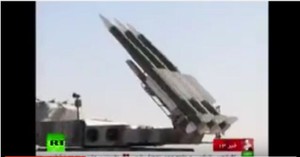
While the media obsessed over the Rob Porter scandal which was interrupted by a school shooting in Florida that left 17 dead, little has been mentioned here of elsewhere about two recent events in the Middle East (exception: Redstate’s streiff has covered the two incidents). But, there is a third interesting development that has come to the forefront that bears mentioning.
The first incident involves an Israeli airstrike on Syrian air defense and artillery installations in that country. This strike was precipitated when what is believed to be an Iranian-made drone flew into Israeli airspace. Rumor has it that they allowed it to enter their airspace so that they can recover the remains to determine if it was a case of reverse engineering of an American drone shot down over Iran. Initial reports are that the Iranian drone had no stealth capabilities. That American drone was shot down in 2011 and the Obama administration laughably asked that Iran kindly return it.
All sides have a different take on what happened as Syria rejoiced that they shot down an Israeli fighter jet (they did, but the pilot ejected and lived and plane crashed in Israeli territory). However, it appears that the Israeli strike was intense and inflicted some serious damage on Syrian air defense capabilities in southern Syria closest to Israel and the Golan Heights. It was also reported that Israel notified Russia regarding the airstrike so as not to target any Russian forces assisting the Syrian military in the area.
In fact, after the economic pow-wow in Davos, Switzerland, Prime Minister Netanyahu flew to Moscow for a 5-hour talk with Vladimir Putin. High on the list of items to be discussed was Hezbollah missile and missile production facilities in Lebanon. Hezbollah is essentially a proxy of the Iranian government.
The second story was the attack by what appeared to be Russian mercenaries on an installation in Syria where the US has advisers. This attack was repelled after overwhelming American air power managed to kill perhaps as many as 200-300 of the attackers. For their part, Russia denies any involvement although we know that at least two of the injured have been treated at Russian military hospitals. This is the same tactic used by Russia in eastern Ukraine and may have been a feeling-out operation gone terribly bad from their side. Further, there were reports that during the operation, the US and their Russian counterparts, like Israel and Russia, were in contact to avoid any direct conflict between Russian and American military forces.
But the third story left in the background is the emerging power dynamics forming. It is clear that Iran, a largely Shiite Muslim country, wants to extend their influence from Iran to the Mediterranean and that path goes through Iraq, Syria and Lebanon. As Russia retreats from Syria having largely attained their goals- upgrading naval bases at Tarsus and Latakia and obtaining an airbase at Khmeiman- they will likely leave behind non-military proxy forces hired by security firms (a firm named Wagner in Russia has been mentioned). But, by removing their regular military forces, it opens the way for Iran to expand their influence.
Iran does not want airbases or naval bases. Their goal is to expand their influence in the Sunni heartland by creating an umbrella above states they view as their chief antagonists- Jordan, Israel and especially Saudi Arabia. Iran is achieving this goal by not only helping to push ISIS out of the way (ISIS is a Sunni organization), but also every Sunni in their path. It is estimated that Iran controls 80,000 fighters in Syria. Another 100,000 Shiite, Iranian-backed fighters are in Iraq. As ISIS is now largely defeated, the fear is that another anti-American presence will emerge willing to stoke sectarian violence.
Israel estimates that there are 3,000 Iranian Revolutionary Guard members in Syria controlling over 9,000 Hezbollah fighters recruited from Pakistan, Syria, Afghanistan and elsewhere. Then there is the presence of Hezbollah in Lebanon making that country basically an extension of Tehran. Israel is clearly not waiting for Iran to claim dominance after the Russians leave. They directly targeted Iranians in Syria, attacked Syrian SAM sites impressively and demonstrated accuracy based on good intelligence. Iran is determined to build a military presence in the Levant through proxies and Israel is equally determined to prevent it.
And Israel has found willing if silent allies in unlikely places- Saudi Arabia and the Gulf states. These countries now view Iran as the biggest threat to their relative stability. While they publicly tow the anti-Israel line, they privately support Israel’s military efforts to thwart Iran designs in the region.
In effect, we have a new Cold War in the Middle East that pits Saudi Arabia against Iran. Through the use of proxies and a series of likely poking and prodding excursions, we will probably see hot spots pop up from time to time. Interestingly, both Russia and the United States are now proxies themselves in this battle between the two Middle East giants, each with differing aims and strategies, but both unwilling to commit large scale forces where the chance of a direct conflict increases.













Join the conversation as a VIP Member